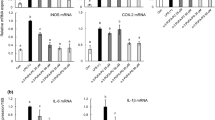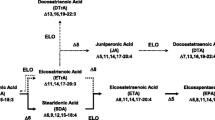Abstract
Many reports have shown the beneficial effects of consumption of pine seeds and pine seed oil. However, few studies have examined the biological effect of pinolenic acid (PNA; ∆5,9,12–18:3), the main fatty acid in pine seed oil. In this study, using murine macrophage RAW264.7 cells as a model, we examined the effect of PNA on polyunsaturated fatty acid (PUFA) metabolism, prostaglandin (PG) biosynthesis and cyclooxygenase-2 (COX-2) expression. Results showed that PNA was readily taken up, incorporated and elongated to form eicosatrienoic acid (ETrA, ∆7,11,14–20:3) in macrophage cells. A small portion of this elongated metabolite was further elongated to form ∆9,13,16–22:3. The degree of incorporation of PNA and its metabolites into cellular phospholipids varied with the length of incubation time and the concentration of PNA in the medium. Incubation of PNA also modified the fatty acid profile of phospholipids: the levels of 18- and 20-carbon PUFA were significantly decreased, whereas those of 22-carbon fatty acids increased. This finding suggests that PNA enhances the elongation of 20-carbon fatty acids to 22-carbon fatty acids. The syntheses of PGE1 from dihomo-γ-linolenic acid (DGLA, ∆8,11,14–20:4) and PGE2 from arachidonic acid (ARA, ∆5,8,11,14–20:4) were also suppressed by the presence of PNA and its metabolite. As the expression of COX-2 was not suppressed, the inhibitory effect of PNA on PG activity was attributed in part to substrate competition between the PNA metabolite (i.e., ∆7,11,14–20:3) and DGLA (or ARA).







Similar content being viewed by others
Abbreviations
- ADA:
-
Adrenic acid (∆7, 10, 13, 16–22:4)
- ARA:
-
Arachidonic acid (∆5, 8, 11, 14–20:4)
- COX-2:
-
Cyclooxygenase 2
- DGLA:
-
Dihomo-gamma-linolenic acid (∆8, 11, 14–20:3)
- DHA:
-
Docosahexaenoic acid (22:6)
- DMEM:
-
Dulbecco’s modified Eagles medium
- DMSO:
-
Dimethyl sulfoxide
- DPA:
-
Docosapentaenoic acid (22:5)
- DTrA:
-
Docosatrienoic acid (22:3)
- EDA:
-
Eicosadienoic acid (20:2)
- EPA:
-
Eicosapentaenoic acid (∆5, 8, 11, 14, 17–20:5)
- ETA:
-
Eicosatetraenoic acid (∆8, 11, 14, 17–20:4)
- ETrA:
-
Eicosatrienoic acid (20:3)
- FACES:
-
Fatty acid chain elongation system
- GC:
-
Gas chromatography
- GC-MS:
-
Gas chromatograph mass spectrometry
- GLA:
-
Gamma-linolenic acid (∆6, 9, 12–18:3)
- NMIFA:
-
Non-methylene-interrupted fatty acids
- PGE:
-
Prostaglandin E
- PNA:
-
Pinolenic acid (∆5, 9, 12–18:3)
- PSO:
-
Pine seed oil
- SDS-PAGE:
-
Sodium dodecyl sulfate-polyacrylamide gel electrophoresis
References
Sugano M, Ikeda I, Wakamatsu K, Oka T (1994) Influence of Korean pine (Pinus koraiensis)-seed oil containing cis-5, cis-9, cis-12-octadecatrienoic acid on polyunsaturated fatty acid metabolism, eicosanoid production and blood pressure. Br J Nutr 72:775–783
Asset G, Staels B, Wolff RL, Bauge E, Madj Z, Fruchart J-C, Dallongeville J (1999) Effects of Pinus pinaster and Pinus koraiensis seed oil supplementation on lipoprotein metabolism in the rat. Lipids 34:39–44
Asset G, Leroy A, Bauge E, Wolff RL, Fruchart J-C, Dallongeville J (2000) Effects of dietary maritime pine (Pinus pinaster)-seed oil on high-density lipoprotein levels and in vitro cholesterol efflux in mice expressing human apolipoprotein A-I. Br J Nutr 84:353–360
Asset G, Bauge E, Wolff RL, Fruchart J-C, Dallongeville J (2001) Effects of dietary maritime pine seed oil on lipoprotein metabolism and atherosclerosis development in mice expressing human apolipoprotein B. Eur J Nutr 40:268–274
Calder PC, Zurier RB (2001) Polyunsaturated fatty acids and rheumatoid arthritis. Curr Opin Clin Nutr Metab Care 4:115–121
Kast RE (2001) Borage oil reduction of rheumatoid arthritis activity may be mediated by increased cAMP that suppresses tumor necrosis factor-alpha. Int Immunopharmacol 12:2197–2199
Engler MM, Schambelan M, Engler MB, Ball DL, Goodfriend TL (1998) Effects of dietary gamma-linolenic acid on blood pressure and adrenal angiotensin receptors in hypertensive rats. Proc Soc Exp Biol Med 218:234–237
Arisaka M, Arisaka O, Yamashiro Y (1991) Fatty acid and prostaglandin metabolism in children with diabetes mellitus. II. The effect of evening primrose oil supplementation on serum fatty acid and plasma prostaglandin levels. Prostaglandins Leukot Essent Fatty Acids 43:197–201
Chapkin RS, Coble KJ (1991) Utilization of γ-linolenic acid by mouse peritoneal macrophages. Biochim Biophys Acta 1085:365–370
Tanaka T, Hattori T, Kouchi M, Hirano K, Satouchi K (1998) Methylene-interrupted double bond in polyunsaturated fatty acid is an essential structure for metabolism by the fatty acid chain elongation system of rat liver. Biochim Biophys Acta 1393:299–306
Levin G, Duffin KL, Obukowicz MG, Hummert SL, Fujiwara H, Needleman P, Raz A (2002) Differential metabolism of dihomo-γ-linolenic acid (DGLA) and arachidonic acid (AA) by cyclooxygenase-1 (COX-1) and cyclooxygenase-2 (COX-2): Implications for cellular synthesis of PGE1 and PGE2. Biochem J 365:489–496
Sprecher H, Luthria DL, Mohammed BS, Baykousheva SP (1995) Reevaluation of the pathways for the biosynthesis of polyunsaturated fatty acids. J Lipid Res 36:2471–2477
Tanaka T, Takimoto T, Morishige J, Kikuta Y, Sugiura T, Satouchi K (1999) Non-methylene-interrupted polyunsaturated fatty acids: effective substitute for arachidonate of phosphatidylinositol. Biochem Biophys Res Comm 264:683–688
McAteer JA, Davis J (1994) Basic cell culture technique and maintenance of cell lines. In: Davis JM (ed) Basic cell culture, a practical approach. Oxford University Press, Oxford, pp 93–148
Mosmann T (1983) Rapid colorimetric assay for cellular growth and survival: Application to proliferation and cytotoxicity assays. J Immunol Meth 65:55–63
Folch J, Lees M, Sloane-Stanley GH (1957) A simple method for the isolation and purification of total lipids from animal tissues. J Biol Chem 226:497–509
Chuang LT, Leonard AE, Liu JW, Mukerji P, Bray T, Huang YS (2001) Inhibitory effect of conjugated linoleic acid on linoleic acid elongation in transformed yeast with human elongase. Lipids 36:1099–1103
Chapkin RS, Miller CC, Somers SD, Erickson KL (1998) Utilization of dihomo-gamma-linolenic acid (8, 11, 14-eicosatrienoic acid) by murine peritoneal macrophages. Biochim Biophys Acta 959:322–331
Leonard AE, Bobik EG, Dorado J, Kroeger PE, Chuang LT, Thurmon JM, Parker-Barnes JM, Das T, Huang YS, Mukerji P (2000) Cloning of a human cDNA encoding a novel enzyme involved in the elongation of long-chain polyunsaturated fatty acids. Biochem J 350:765–770
Leonard AE, Kelder B, Bobik EG, Chuang LT, Lewis C, Kopchick JJ, Mukerji P, Huang YS (2002) Identification and expression of mammalian long-chain PUFA elongation enzymes. Lipids 37:733–740
Li G, Barnes D, Butz D, Bjorling D, Cook ME (2005) 10t, 12c-conjugated linoleic acid inhibits lipopolysaccharide-induced cyclooxygenase expression in vitro and in vivo. J Lipid Res 46:2134–2142
Yang P, Chan D, Felix E, Cartwright C, Menter DG, Madden T, Klein RD, Fischer RM, Newman RA (2004) Formation and antiproliferative effect of prostaglandin E3 from eicosapentaenoic acid in human lung cancer cells. J Lipid Res 45:1030–1039
Berger A, Monnard I, Baur M, Charbonnet C, Safonova I, Jomard A (2002) Epidermal anti-inflammatory properties of 5, 11, 14 20:3: Effects on mouse ear edema, PGE2 levels in cultured keratinocytes, and PPAR activation. Lipids Health Dis 1:5
Tanaka T, Hattori T, Kouchi M, Hirano K, Satouchi K (1998) Non-methylene interrupted polyenoic fatty acid: structural characterization and metabolism by fatty acid chain elongation system in rat liver. In: Riemersma RA, Armstrong R, Kelly RW, Wilson R (eds) Essential fatty acids and eicosanoids. American Oil Chemist Society Press, Champaign, IL, pp 229–233
Matsuo N, Osada K, Kodama T, Lim BO, Nakao A, Yamada K, Sugano M (1996) Effect of γ-linolenic acid and its positional isomer pinolenic acid on immune parameters of Brown-Norway rats. Prostaglandins Leukot Essent Fatty Acids 55:223–229
Acknowledgments
This work was supported in part by grants (95-2313-B-264-001- and 96-2320-B-264-001-) from the National Science Council, Taiwan.
Author information
Authors and Affiliations
Corresponding author
About this article
Cite this article
Chuang, LT., Tsai, PJ., Lee, CL. et al. Uptake and Incorporation of Pinolenic Acid Reduces n-6 Polyunsaturated Fatty Acid and Downstream Prostaglandin Formation in Murine Macrophage. Lipids 44, 217–224 (2009). https://doi.org/10.1007/s11745-008-3276-0
Received:
Accepted:
Published:
Issue Date:
DOI: https://doi.org/10.1007/s11745-008-3276-0




